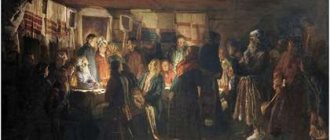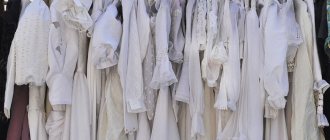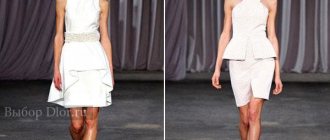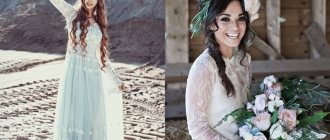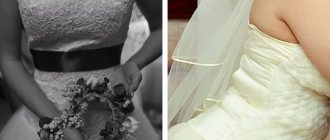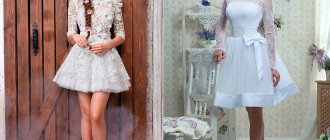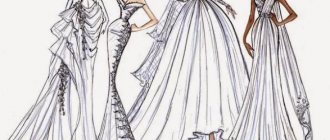Slavic dresses: ethno-style and memory of Native roots
Slavic dresses are wedding dresses, ritual and festive clothing, women's shirts, now called tunics.
All of them are sewn from linen, cotton or natural knitted fabrics, and decorated with ornaments. The most common way of applying protective symbols to a Slavic dress is embroidery. Since ancient times, it was believed that every stitch has power: just as sounds in a letter, and letters give rise to a word, and a word is a sentence, so every cross or knot connected into one single ligature can create a powerful energy and information message: attracting good luck, maternal and female share, family protection.
On women's dresses in the Slavic style you will see symbolic images of Beregins and Women in Birth, Lada, Lelya and Mokosh, signs and chirs of Perun, Ladinets, Kolyadnik and Kolovrat. They are the ones who look after their “children”, help them to go through the difficult path of life in Yavi, to be healthy and happy.
It is recommended to keep Slavic wedding dresses as a family heirloom and wear them on occasion: a holiday in honor of our Gods or in illness and trouble.
Russian traditional bride's outfit
What did girls in Rus' wear when they got married? Then there were times when newlyweds sewed at least four dresses for themselves for the wedding: different outfits were intended to be worn for the feast, wedding, bachelorette party and engagement. The girl wore bright red wedding dresses to the festive feast. The outfit was decorated with embroidered national ornaments or flowers. The more wealthy the girl’s parents were, the more richly the newlywed was dressed. The wedding set of the Russian beauty consisted of:
- red sundress,
- white shirt,
- many petticoats,
- apron,
- wide belt.
In ancient times, the role of a headdress was played by a wreath of fresh wildflowers, ribbons and hoops, which were attached to the forehead and back of the head. And after the obligatory wedding, the bride’s hair was braided. forming two tight braids, wrapped them around the head, and put on a scarf with a kokoshnik, a warrior or a magpie. The wedding sundress was embroidered with gold and silver patterns, decorated with braid and bright beads.
Ritual and wedding dresses in Slavic style: buy for protection and help
Our catalog contains works by masters and craftswomen who sew ritual and wedding dresses in the Slavic style, which is now so fashionable all over the world. Every detail of the style, every line of the ornament is carefully worked out by the author of the product and, in addition to the aesthetic pleasure from the beauty and naturalness of the material, gives the owner of the clothing a feeling of powerful protection and constant support of the Native Gods.
You can choose and buy a Slavic dress from our catalog and order it tailored according to your size charts, ask for advice and receive recommendations on adding suitable accessories to your clothes: belts, headdresses and jewelry: wedding rings with Slavic symbols, protective bracelets or earrings.
Don’t be afraid to demonstrate your belonging to the Slavic Family - be proud of your great ancient roots!
Dress “a la russe”
Ethnic motifs have recently become increasingly popular. The fashion for Slavic style has not escaped the wedding industry either . Dresses a la russe are a harmonious combination of classic wedding dresses with folklore elements inherent in ancient Russian fashion.
The style of the dress can be any: fluffy or tight-fitting, short or long, but the following elements must be present.
- Embroidered national patterns can cover the entire outfit or some part of it, for example, the bodice, hem or sleeves. White, red, blue, silver or gold threads are used for embroidery.
- A headdress in the form of a wreath of wild flowers or a thin hoop. You can attach a long multi-layer veil to it.
- Jewelry in the Old Russian style: large earrings and bracelets, pearl necklaces, massive rings.
- In winter, a fur cape and muff would look appropriate.
Also popular elements of wedding dresses in the a la russe style are:
- flashlight sleeve;
- full skirt with a train;
- wide belt decorated with embroidery, pearls and rhinestones.
Editor's choice: Badges and ribbons for witnesses for a wedding, master class with photos
These details, combined with a classic wedding dress, will help the bride create a unique and memorable image.
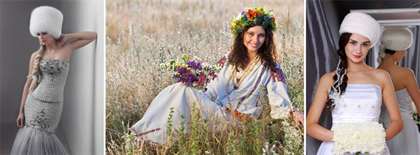
Beauty secrets of flax
Amazingly beautiful Russian women's dresses attract the eye and create a warm atmosphere. When you look at the combination of soft lines and bright fields of embroidery, you get a feeling of something familiar and familiar for a long time.
Agree, there is something elusively attractive in every embodied image. The combination of simple details combined into complex compositions is inspiring. And at the same time, the gaze never tires of scanning every feature.
Russian style is a whole universe that embodies:
-the beauty of simple lines;
- highlights the individuality of the owner;
- forms attractive shapes, decorating any figure;
-unobtrusively focuses attention on the national idea.
Consequently, the Russian style dress, in which it is created from simple and natural fabrics, immediately becomes an adornment for a woman and a message to the world around her.
Great and varied
In your search for ideas, you have probably come across clearly different costumes, which some called Old Russian, others Slavic, but in fact, they are all Russian folk.
We should not forget that Rus' has always been Great and had many provinces and separate settlements, the styles of clothing in which, despite the similar cut, had obvious distinctive features in the decor.
Now I will not list them all, but I will note that the main differences were the patterns used (paintings on fabric, hand embroidery) and the abundance of decor, the amount of which depended on the occupied status of the family. These could be geometric or floral patterns with a predominance of red, gold, and sometimes blue, necessarily carrying a hidden subtext. In those days, it was believed that embroidery was a strong talisman.
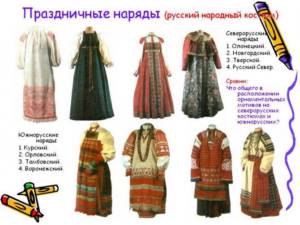
The most amazing thing is that absolutely everyone’s clothes were also divided according to their purpose. Depending on the event, a certain type of clothing was worn.
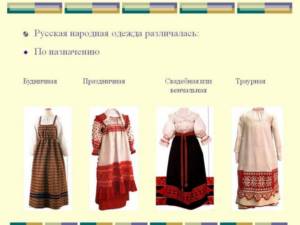
Folk embroidery - amulet and decoration
When considering Russian style dress models , you should pay special attention to the embroidery trim. It creates the main center of the composition, placing accents and forming a certain geometry.
The Slavic online store “Veles” offers dresses and tunics decorated with cross and satin stitch embroidery. Each detail has a decorative purpose, and at the same time preserves the true purpose of the patterns.
Our ancestors laid enormous positive potential in every symbol. By decorating clothes with these patterns, you receive positive settings for your subconscious. Therefore, clothing in the Russian style sets the owner up for success, health and happiness.
Modern models of dresses in Russian ethnic style
Modern models of dresses in Russian ethnic style will give the bride sophistication, originality and the appearance of a real Slavic beauty. Unlike traditional costumes that are popular in Rus', wedding dresses from famous fashion designers do not look old-fashioned or ridiculous. They fit perfectly into the concept of a celebration in folk style, emphasize and enhance the beauty of Russian girls and evoke thoughts about the rich history of the Russian state.

Distinctive features of Russian ethnic wedding dresses:
- combination of white and red colors;
- embroidery and appliqués, extraordinary artistic solutions;
- beads on fabric;
- colorful, bright, eye-catching models;
- numerous unusual finishing options (large cuffs, collars, ruffles, frills);
- variety of decorations.
Traditional Slavic motifs will emphasize the bride’s patriotism, her reverence for the history and customs of Rus', highlight the advantages of Russian beauty and turn any girl into a luxurious princess.

Among the modern models of wedding dresses in ethnic style, you can find simple but stylish floor-length sundresses, chic suits with blouses and skirts, and even short, tight-fitting dresses of various silhouettes.
Of course, the most excitement will be caused by a long fluffy dress in white and red tones with voluminous sleeves, a multi-layered skirt, painting, stripes, appliqués, pearls, beads, openwork ribbons and braid, flowers, large flounces and a massive belt. This outfit is a real historical design that goes well with the typical Slavic appearance and leaves all guests speechless.

Russian ornaments - flowers, birds, Khokhloma - look expensive and stylish on a wedding dress. An important condition for a harmonious image is the unity of hairstyle, makeup, shoes and main outfit, as well as accessories. A bride in the Russian style can look both very elegant and modest, depending on the style of the outfit.

The combination of white and red colors for the bride is perhaps the most successful. White traditionally symbolizes purity and tenderness, while red symbolizes leadership and passion. As a result, the bride seems fragile and feminine, but at the same time strong and strong-willed. The game of contrasts will make her image piquant and balanced.
REFERENCE! For girls who find an ethnic wedding dress too extravagant, a classic sundress in a minimalist style combined with traditional jewelry and accessories is suitable.
Embroidery in an ancient motif or a fur detail will add a touch of charm and homeliness to the girl.

A common version of the ethnic costume in the Russian style is the godet style dress. This is a model that combines a rather narrow top and a fluffy bottom. At the same time, ethnic outfits do not always fit tightly to the body, but the upper part acquires a clear silhouette, which is very beneficial for girls with a thin waist and an hourglass figure.

Puff sleeves made of translucent fabric or long flared sleeves will help make the top airy. Such an outfit will be as comfortable and aesthetic as possible, will be devoid of vulgarity and will not reduce the beauty of the Russian bride.

Romantics can add French motifs to their look. For this, brides should pay attention to Slavic lace.

The most unusual wedding outfit is the traditional Russian sundress. Typically, the outfit consists of a loose, airy white blouse with wide sleeves and a colored sundress worn on top. Most sundresses are red, but there are also other colors, such as blue or yellow.

REFERENCE! A Russian wedding sundress will look great on girls with a triangle figure.
External fluffiness is achieved through the cut of the skirt, but at the same time the sundress is sewn from one layer of fabric, providing freedom of movement and comfort during dancing and outdoor games. Also, this model is suitable for plump girls and will unobtrusively hide all the flaws on the waist, hips and hide plump legs.

Medium-length dresses in Russian ethnic style are suitable for slender, long-legged beauties. In order not to vulgarize the image, they can be worn with traditional Russian boots, which will be appropriate for a winter holiday. With this outfit you can safely wear a sheepskin coat.

Shortened models are also not devoid of Slavic grace and warmth. They are decorated with numerous bright embroideries and decorations, delicate lace, rustic braid, playful collar and light sleeves.
Silver and gold stripes on the dress will give the bride the luxurious chic of the times of Imperial Rus'. The wedding celebration will turn into a real ball, and the girl will look like a queen - stately, chic, attractive. Pearls and feathers will add even more character to the look.
Stylized Russian wedding dresses are a white dress of any style with a blue or red pattern. Embroidery, floral patterns and typical trim would be appropriate here: wide sleeves, a stand-up collar, braid and lace.
Slavic art looks great on A-line dresses. They embody grace and elegance, thanks to the combination of a sophisticated bodice - open, but rich in decoration - and a full skirt. This outfit appeals to many girls, because it goes well with any body type.

REFERENCE! To visually elongate the silhouette, you need to choose a dress with vertical contrasting patterns and stripes.
The most daring outfit a la russe is a tight-fitting wedding dress. It can have a discreet cut, rich painting, and airy puff sleeves. Such a dress with a long train will look very elegant, and a bolero, fur cape or stole with Slavic ornaments will help to balance the upper and lower parts.

An extravagant and specific outfit is a shirt dress. This is a rather interesting style with extraordinary patterns and embroidery of floral or animal motifs, made of natural linen or cotton. A distinctive feature of this dress is the puffed sleeves, decoration with printed designs and Gzhel or Khokhloma ornaments, usually of medium length.

In addition to a variety of styles and models, there are bright folk dresses in rich blue or red colors.

A soul warmer will go well with a formal wedding dress, especially if the wedding is winter. This is an ancient Russian motif that will definitely fit into the concept of the holiday. Dushegrey is an elongated jacket made of thick fabric, embroidered with gold or silver threads, sometimes complemented with fur trim. The combination of a dress and a warmer will allow the bride to mislead all the guests who think that the girl chose a two-piece suit for the celebration. When she takes off her jacket, those invited will be pleasantly surprised.

IMPORTANT! The soul warmer is often tied with a simple thin belt directly under the chest, which looks very flattering on curvy girls of average height and visually lengthens the legs.
The belt, which is often an integral attribute of a dress in Russian ethnic style, deserves special attention. It can be thin or wide and helps to highlight the waist or hide imperfections.

A belt tied with a simple knot will harmoniously fit into the image of the bride. If there are still free flowing ends left, they are twisted so that the style is fully maintained. Belts are also embroidered with ornaments or decorated with flowers and stones.
Models you want to wear
What is a dress in Russian folk style? The answer is easy and difficult at the same time. The peculiarity of folk cut was the practicality and convenience of details:
- gusset allows you to add freedom of movement;
-the obliquely sewn sleeve forms a soft shoulder line;
-loose fit maintains comfort under clothing;
-convenient neck slit with ties.
The peculiarity of such details allows you to create a favorable look for any type of figure. A slender figure will sparkle with the colors of tenderness and lightness. The volumetric type of addition will acquire advantageous features that focus attention only on the winning details. By adjusting the waist level with a woven belt, you can create various compositions based on the requirements for the final result.
A-line wedding dress
More and more brides are choosing A-line wedding dresses. The peculiarity of its style is that the bodice smoothly transitions into a loose skirt. Thus, the dress perfectly hides figure flaws and is suitable for girls of any build.
This outfit is perfect for a wedding in a folk style, and unlike the Slavic sundress, it has another advantage - the dress looks good both with and without a neckline.
Editor's choice: Wedding on Valentine's Day: an unforgettable holiday, photo review
Lace inserts and a train will give the outfit a festive look, and the ethnic ornament on the bodice will add a real Russian flavor to the image.

To the floor or to the knee?
Another feature of dresses in the Russian style is the widespread use of linen and natural fabrics. Linen has many advantageous qualities:
- maintains a stable microclimate under clothing at any time of the year;
- easily removes sweat;
-does not retain odors;
- easy to wash;
- tear resistant;
- pleasant when in contact with the skin.
Therefore, when considering a linen dress, which can be purchased on our Slavic website, the buyer makes a choice in favor of health and comfort.
The site catalog offers two product options. The first group reflects stylization of folk style. The length of these dresses reaches the floor level, completely covering the feet. This silhouette is great for short or heavyset women. It extends the visual line of perception.
The shortened version creates a playful look, full of spring freshness and youthful beauty. Ideal for those with beautiful slender legs. Each model has several variations that have more modern features or folk flavor.
How to create a harmonious image
In ancient times in Rus', it was not customary for girls to let their hair down, except for a special ceremony. Before the wedding, the bride's braid was unraveled, and after the wedding ceremony, upon returning from church, the newlywed was given two thick braids and then a scarf or kokoshnik was put on her head - this hairstyle symbolized the status of a married woman.
Nowadays there is no need for the bride to hide her hair. If a girl has luxurious long curls, you can leave them loose or slightly curl them and decorate them with a wreath, hoop or ribbon.
You can braid one or two braids and decorate them with a satin ribbon:
A popular option is a headband braid.
Master class video:
The “basket” hairstyle is not the simplest option, but incredibly beautiful.
You can learn how to do this hairstyle from the video:
Traditional headdresses will help add color and national authenticity to the image of the Russian bride: the famous kokoshniks, more modest crowns, colorful scarves.
The bride's look will be incomplete without a long, airy and translucent veil made of tulle or lace:

As for accessories, jewelry made in folk style is best suited: large earrings in the form of flowers, fruits or berries, massive bright red beads and necklaces, baubles, lace mittens, wide bracelets with intricate ornamental embroidery and floral decoration.
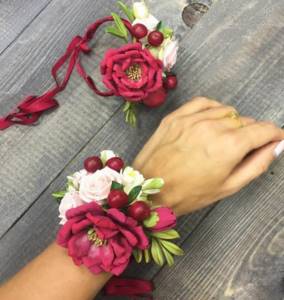
For obvious reasons, flashy, complex makeup is not expected in the traditional image of a Russian bride. However, this does not mean that you cannot use cosmetics. Classic Russian makeup includes a light blush on the cheeks, red lips (in the old days, girls tinted them with beets), thick black eyebrows (the outline of the eyebrows was previously created using ash). You can line your eyes with pencil or make them wider and larger with light shadows at the bottom corner of the eye.
You can also lightly tint your eyes with cherry or burgundy shadows (to match the blush). However, with red shadows, a girl should be very careful - one wrong move and the image will turn out tired and even painful.
The winter look of the bride is complemented, as mentioned above, with a warm fur hat or a bright stole. In addition, in order not to freeze, you must wear a sheepskin coat or a long fur coat, decorated with a colorful colorful scarf on top.
What did an ancient Russian wedding dress look like?
The 19th century was characterized by the emergence of fashion for white wedding dresses; before that time, brides wore blue, red, and sometimes even black dresses, which was considered the norm. Almost always the young woman wore a skirt, a festive shirt, or a sundress. To make the wedding look harmonious and complete, neck decorations were added to it, with a special winding, to which the kokoshnik was tied with bright ribbons. An ancient Russian wedding dress is a bright sundress, complemented by interesting embroidery.
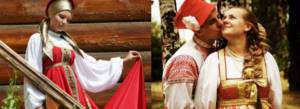
A little history about wedding dresses in Rus'
The people of Rus' differed from others in their traditions and rituals, this also applied to weddings. Brides sewed their own outfits for the wedding, believing that by doing so the girl protected herself from evil and envious glances, and from various troubles.
It doesn’t matter whether the bride is from a rich family or from a poor one, she personally worked on creating her wedding image
Girls in Rus' sewed wedding dresses and sundresses from chintz, linen or velvet, decorating the outfit with patterns of embroidered threads of silver and gold, beads, multi-colored satin ribbons, and braid. The richer the bride was considered, the more luxurious her outfit. Girls from wealthy families used multi-colored stones, pearls, silver and bronze details to decorate wedding dresses and sundresses. In the cold season, noble fur capes were worn over the wedding dress. Simpler girls wore less beautiful furs.
Russia Style haute couture
The bright and original Russian folk style has haunted fashion designers around the world for several decades.
One of the most famous collections of maestro Yves Saint Laurent was called “Russian Operas and Ballets,” which he presented in 1976. The master himself considered it his most beautiful work. In it he used fluffy long skirts with leather belts, fur hats, vests, boots, and painted scarves. In the same year, the collections of fashion houses Dior, Ungaro, Lanvin were replenished with clothing models with elements of the old Russian style. Of course, domestic designers support Russia style more actively than others.
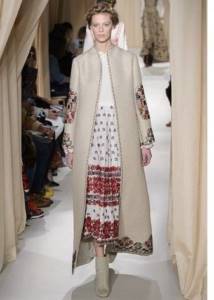
Vyacheslav Zaitsev is the most prominent representative of the Russian style in fashion. Not a single collection of his is complete without one or another variation of the traditional costume.
Denis Simachev weaves elements of Russian style into hooligan street fashion. This is for the young, bright, brave. Soviet symbols are also actively used in his collections.
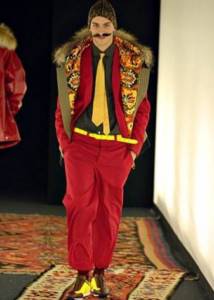
But designer clothes from Alena Akhmadullina will not leave tender, sophisticated young ladies indifferent. A quick glance at the assortment of her store is enough to see traditionally cut skirts and dresses, printed coats, and sundresses. Modern materials allow you to wear all this beauty while living in a dynamic metropolis.
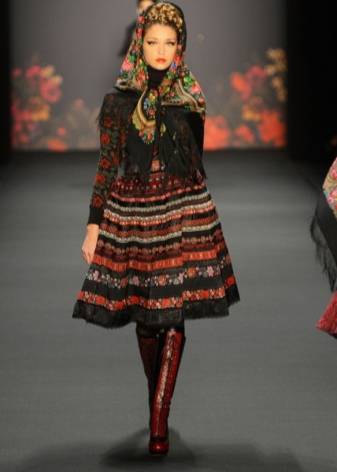
Ulyana Sergeenko’s collections are distinguished by their originality and elegance, as well as what she wears herself. The entire Russian aesthetic - cut, fabric colors, accessories - in her interpretation looks elegant and sexy, but without the slightest touch of vulgarity. It is difficult to find a basic item in her collections - they are all bright, “for a special day.” However, in this style, every day has every right to be “special.”
Fashionable evening dress in Russian folk style
“Russian chic” is also present in evening fashion. This trend has simply become trendy. For the first time, such a combination was presented on the Paris catwalk a couple of seasons ago. The collection of young and talented Russian couturiers simply shocked everyone. They worked with folk traditions so gracefully that it was impossible to take your eyes off their creations.
This trend is becoming more and more popular. It was appreciated by those who prefer originality and uniqueness.
Evening versions of dresses in folk style are a combination of the silhouettes and colors that are familiar to us, which are typical for folk costumes.
Today the effect of combining incongruous things is highly valued. But to skillfully create such an effect, you need to try hard. Luxurious hemlines with interesting prints, stylized patterns and ornaments are complemented by a beautiful tight-fitting bodice, from which it is difficult to take your eyes off. As a rule, contrasting shades complement the overall picture.
Purity, brightness and richness of beauty are one of the most important characteristics of the style. All this is in perfect harmony with the decoration and gold embroidery. Moreover, this is not just a tribute to tradition, but a real fashion boom. Folk style dresses are often decorated with lace, especially handmade ones. Such pleasure is not cheap.
Check out the perfect combination of evening and folk style in the dresses in the photo:
This interpretation of folk costumes belongs to high fashion and is highly valued among all lovers of beauty.
LiveInternetLiveInternet
Russian wedding costume
The bride's wedding dress in Rus' had many variations, but two main traditions can be distinguished: northern and southern.
The main wedding costume of the 19th - early 20th centuries. for the entire North, the Urals and the Volga region there was a set of clothing with a sundress. Girls of marriageable age were especially dressed up not only on holidays, but also on weekdays. Peasant youth met and met at gatherings and “games,” so future brides had to look attractive, show their skill in handicrafts and the well-being of their family. Russian North.
Cis-Urals. Middle Volga region Wedding shirt - “whole shirt”
1890s Vyatka province, Yaransky district, village. Vaskino
The wedding shirt (“Kalinka”, “Dolgostanets”, “healer”) as part of the wedding dress was a symbol of the bride’s innocence. In the Russian North, the “wedding collar” was known - the upper part of the shirt with puffy, elbow-length sleeves or with long, tapering downward so-called “weeping” sleeves, reaching a length of up to 130 cm. Wedding shirts with sleeves no longer than the arm were also widely used. They could taper toward the wrist, have wedges, or be gathered into cuffs or trims with frills at the edges.

The wedding shirt is a “whole shirt”, originating from the village of Vaskino, Yaransky district, whole-cut, almost reaching the length of the feet. The process of making fabric for a wedding shirt was more labor-intensive than weaving regular canvas. The panels were made in blanks to the size of the length of the future shirt. The blank of this shirt consisted of a patterned border in the form of a strip of pink ornament made from a large zigzag line, made using the technique of embedded weaving, and the double stripes bordering it and white plain weave canvas9. To sew a “whole-length” shirt, three and a half pieces of thin homespun flax were needed. The deep oval neckline is created by tightly gathering the front and back panels and the middle part of the top of the sleeves under the narrow linen trim. There is a slit in the middle of the chest that is tied with a cord. The sleeves, slightly tapering downward, are made of one piece of fabric and two wedges, gathered at the wrists. Diamond-shaped gussets are sewn under the sleeves. The shirt is finished off with light ruffles made of linen and cambric fabric, sewn along the edges of the hem and sleeves. Girl's wedding suit
Beginning of the 20th century Novgorod province, Ustyug district
The wedding suit includes a white two-piece shirt, a dark blue homespun linen sundress with a straight cut, and a woven belt. The bride complemented her outfit with beads.
The upper part of the shirt is sewn from three straight panels of factory fabric with a slit in the middle of the chest. Straight sleeves made of solid panels reach to the elbows, where they are gathered into frequent gatherings under the coverings. Wide fluffy frills are sewn onto them. The upper edges of the panels and the middle part of the sleeves, gathered in frequent gathers, form a rounded neckline. A thick frill is attached to it, sewn along the top with tape. Diamond-shaped gussets are sewn under the sleeves. The lower part of the shirt - the “bed” - is sewn from three straight panels and one wedge of coarse homespun flax. The ritual purpose is emphasized by a phallic figure embroidered with white threads in the upper part of the frame on the right side, endowed, obviously, with a productive meaning. The sleeve frills and trims are decorated with cross-stitched patterns made with red and black threads. The ornamental motifs of multi-petal flowers, fruits and leaves were borrowed by peasant women from pattern books or supplements to the Niva magazine. Strips of white factory lace are sewn along the edges of the neckline and frills, giving the snow-white shirt lightness and airiness. The sundress is sewn in the form of a high skirt from seven straight panels of dark blue fabric. The two front panels are 10 cm longer than the rear ones, with which they are connected by triangular side inserts. In the upper part, on the back and chest, the panels are gathered under a narrow trim and small tucks (on the back - counter pintucks), secured along the front side with red woolen thread. There is a small slit in the middle of the chest, fastened with a hook. Long narrow straps are attached to the chest and middle of the back. Along the bottom, the sundress is decorated with a large ornament made using the applique technique of red patterned chintz: a chain of rhombuses on both sides is framed by narrow horizontal stripes. In the upper part of the sundress, the edges of the lining are marked with red chintz trim. Added after 8 minutes
Bridal suit
1870s Vologda province, Solvychegodsky district (Veliky Ustyug region)
The costume was accompanied by a scarf, which was worn on the shoulders, tucking the two ends into the straps of the sundress. It is made of orange cotton fabric. The lower corner of the scarf is decorated with two woven stripes with images of multi-colored anthropomorphic figures on an orange background, similar to the decor of a shirt. A lush fringe is tied to the edges of the stripes.

Added after 2 minutes
Bridal suit
1870-1880s Vologda province, Solvychegodsk district
The second costume of the newlywed from Solvychegodsk district is similar in the set of details to the one described above, close to it in cut, differing slightly only in details. However, its color scheme is dominated by contrasting red and white colors, traditional for peasant clothing.
The shoulder decoration of the costume is a white scarf. Its lower corner is marked with wide sewing stripes of a red braided ornament. The pattern contains images of female figures that have childbearing symbolism and reflect the ideas of the ancient Slavs about the pagan deity - Mokoshi. Trimming the edges of the apron, sleeves, and scarf with narrow frills of rich red chintz gives the costume the necessary completion. Added after 2 minutes
Women's wedding suit
The end of the 19th - the beginning of the 20th century. Vyatka province, Malmyzh district
A fairly large part of the Russian population that did not accept the church reform of Patriarch Nikon (mid-17th century) was called Old Believers or Old Believers. There are several known movements in the Old Believers, within which various associations—“concords”—existed and still exist today. Among the Old Believers of the so-called Fedoseevsky consent of the Vyatka province, who did not recognize the priesthood, and therefore, church marriage, instead of a wedding there was a betrothal rite. After reading a prayer with lighted candles, as a rule, the mother of the groom, taking the newlyweds by the hands, led them around the table that stood in the “red corner” and blessed them with the icon. Then the newlyweds rode around the village on a cart decorated with carpets, bells, belts, and towels, thereby publicly announcing their desire to live as one family.
Southern provinces of Russia
Girls' wedding suits
Beginning of the 20th century Voronezh province, Biryuchensky district
Going to the crown, mourning her carefree, free life, the bride from Biryuchensky district put on “sad” clothes, consisting of a white shirt, a black sundress, an apron, a belt and a headscarf. The white wedding shirt was called the “old woman’s shirt.” The name of the shirt is due to the fact that it could be worn not only by the bride, but also by the old woman. The wide-shoulder sundress was replaced by a sundress with narrow straps. It was sewn from two solid panels (one at the front and one at the back) and four beveled sides; in the upper part of the panel, the front and back were trimmed with stripes of blue satin. Narrow satin straps connected in the middle of the back. The chest part of the sundress was decorated with a strip of embroidery made with colored wool threads.

She said goodbye to girlhood and “free will”, “died” in her past carefree life in order to be “reborn” after the wedding in a completely new capacity for her - a woman-wife. Newlywed costume
Early 20th century. Voronezh province, Biryuchensky district, village. Afanasyevka
Upon returning from church, before the wedding feast, the girl was changed, and she appeared before her young husband, relatives and guests in a transformed form.
Her head was crowned with a closed headdress - a “magpie”, decorated with gold embroidery. Girls' clothing - a sundress - was changed to "woman's" - without fail. The outfit in which the newlywed was dressed after the wedding in the village of Afanasyevka included a shirt with “golden straps”, a “stacked” poneva, an apron-“curtain”, a belt, a belt-“girdle” and a headdress – “magpie”. It was made from home-made materials: wool, hemp, and sometimes purchased cotton threads were used. If the bride was from a wealthy family, her outfit included expensive materials: velvet, beads, sequins, colored silk ribbons. In different provinces of Russia there were many options for the decorative decoration of ponevs. Even in the neighboring villages of the Biryuchensky district, wedding ponevs differed in color, the nature of the pattern, and had different names: “potrinitka”, “on a slank”, “inlaid”. The busiest one was Poneva “Potrinitka”; the cells of its fabric were embroidered in a looped stitch with dark red threads, resulting in the fabric resembling thick, thick fur. To obtain a looped seam, wooden rods were placed under the threads, which is why this technique was called “embroidery on rods.” Laid-up poneva, rear view Added after 1 minute
Bridal suit
1920s Penza province, Kerensky district, village. Vyazemka
This outfit was both wedding clothing and a costume that a woman wore on major holidays before the birth of her first child. It consists of a shirt, a swing cut poneva, a belt, and a chest decoration, a gaitan. This outfit was worn with a two-horned magpie decorated with gold embroidery.
Added after 2 minutes
Women's wedding suit
Beginning of the 20th century Kursk province, Sudzhansky district
In some areas of the South of Russia, the sundress was not only girls', but also women's clothing. Wealthy brides from the Sudzhansky district of the Kursk province sewed a costume for their wedding, consisting of a shirt, a sundress-coat made of scarlet damask, an apron, one or more belts, a headdress, breast jewelry, and earrings.
With a sundress-fur coat, the young woman wore a kokoshnik, embroidered with gold threads, consisting of a kichka-hairline, the kokoshnik itself, the back of the head and a silk scarf. Wealthy brides purchased necklaces made of round mother-of-pearl grains, often complemented with silver coins, and silver earrings for their wedding costume. Wedding clothing in this region is characterized by decorativeness, contrasting, and often unexpected color combinations. Sometimes not one, but several belts were prepared for an outfit, of which two were silk, purchased, usually of different colors and shades, and several wide and narrow home-made ones with multi-colored stripes. The headdress was complemented with bouquets of paper flowers and ribbons.
Source https://floristic.ru/forum/showthread.php?t=3918&page=2
Hairstyles and hats
The hairstyles and hats of girls and married women differed. The girls did not completely cover their hair; they let it loose over their shoulders or braided it in one braid. When visiting church, girls covered their heads with scarves.
Kosnik, XVII century.
According to ancient tradition, girls decorated their braids with braids (braids) - ribbons with richly ornamented ends or voluminous figured pendants, most often triangular or heart-shaped. They had a loop at the top into which a cord or braid was threaded and woven into a braid. Braids were embroidered with gold or silver threads, pearls, fringe and lace. The motifs of the ornaments were floral patterns and bird figures.
Headband from the Solvychegodsky district of the Vologda province at the beginning of the 19th century. sewn in the form of a strip of red calico on a solid birch bark base with long brocade ribbon ties, duplicated with cotton fabric. To add weight, planks are sewn into the ends of the ribbons. The upper part of the bandage and the tape are fastened with metal hooks. Such headbands had a festive and sometimes wedding purpose. The betrothed girls attached a special detail to the headband - an oval crown that covered the top of their hair.” The bandage was worn with a silk sundress, a cambric shirt and a gold-embroidered soul warmer.
Headband from the Arkhangelsk province of the 19th - early 20th centuries. It is a strip 23 cm wide on a solid base, trimmed with a factory-made braid - “khaz” with a foil headband and a multi-tiered scalloped bottom that goes down to the eyebrows. Wide ribbons of pink moire could be attached to the back of the bandage using a brooch.
At the wedding, girls were not supposed to completely cover their braids or loose hair. The headdress was a bandage - a “ribbon” in the form of a wide strip of braid with a pearl or beaded mesh sewn along the bottom. In the Arkhangelsk, Vologda and Vyatka provinces, sometimes the braid was hidden under a long white knitted cap, called “honest”. The most common wedding headdresses in the Russian North and the Urals were also “golovodets”, “crown”, “kennel”, “bangs”. They always had an open top, had an arched shape or were made in the form of a wide hoop, which was decorated with a wreath of artificial flowers and ribbons. Richly embroidered with patterns of gold threads, decorated with pearls, mother-of-pearl, colored cut glass, foil and gimp, the decorations resembled fabulous precious crowns. An indispensable attribute of a wedding suit was a veil, or “haze” - the finest silk fabric or silk scarf, trimmed along the edges with fringe, lace, and ribbon.
Earrings, rings, necklaces made of pearls or beads, and amber beads, which, according to popular belief, brought happiness in future family life, served as spectacular additions. In this outfit, the bride appeared before the altar as a real “young princess,” as she was called according to her wedding rank.
The price of the outfit was very high even for wealthy peasants, so they considered it as a significant part of the inheritance, passed on from generation to generation. It is known that the cost of some wedding headdresses in the 19th century. reached three hundred rubles in banknotes.

Kokoshnik, XVIII - early XIX century, Tver province.
The most important element of the wedding after the wedding in the church was the ritual of putting on the head - a pre-marital female headdress - “bowing”, “twisting”, “adopting the law”, “removing the veil” (Arkhangelsk, Zologda, Vyatka provinces). The girl's hairstyle was changed to a woman's: the braid was unraveled, the hair was braided into two braids, which were placed around the head and then tucked under closed headdresses - kokoshnik, morshen, borushka, povoinik, kiku, magpie.
Thus, in the Slobodsky district of the Vyatka province, after the wedding, the newlywed was taken to a closet, where the matchmaker and other women “develop a wattle (braid) and twist two wattles, i.e.
two braids are braided, and when they put on a morshok, a type of cover made of brocade or silk material, embroidered with gold or silver, then everyone participating in the “wedding” train puts money under the morshok on the braids.” Kokoshniks made of velvet, embroidered with gold threads, in the shape of a high cylindrical hat with a flat bottom and an openwork bottom made of beads, were widespread in the northwestern provinces of Russia. Usually a scarf was worn over the kokoshnik. Wedding headdress “magpie”
from the Biryuchensky district of the Voronezh province (early 20th century) Southern provinces of Russia
The “magpie” wedding headdress consisted of three parts: a kichka with small sharp horns, the back of the head and the magpie itself, which was heel-shaped.
The magpie is an ancient headdress for Russian women in origin and the way it is worn. Thus, in the Old Believer writings of the 1660-1680s. (“List 1 from the letters of the suffering archpriest Avvakum”) the term “magpie” is mentioned, its components are mentioned, it is indicated that “the woman wore a magpie on her kitty” high above her forehead. Sometimes the magpie was made by the peasant women themselves, but more often it was sewn to order or bought at fairs.
This costume was preserved in the Voronezh region
like pre-1950s wedding attire
Shawls. Borushka
The scarf, an obligatory part of the Russian costume, was widely used in wedding ceremonies. The dowry included scarves of various purposes, both home-made and factory-made. To the rich brides of the Kargopol district of the Olonets province in the middle - second half of the 19th century. Several gold-embroidered scarves were prepared.
The tradition of embroidery with gold or silver threads has a centuries-old history in Russia. The scarves were made from thin white cotton fabric and decorated with embroidery using the “attached” technique or chain stitch.
Shawls. XIX century Olonets province Kargopol district
Yellow, gold-colored cardboard or paper was placed under individual elements of the pattern to create relief. Figured flowerpots, fancy flowers, buds, curved branches, leaves were organic elements of large, well-composed patterns located in one corner of the scarf. The other two corners were decorated with small embroidered bouquets and twigs. Sometimes the owner's name was embroidered along the edge of the scarf. The scarf could be worn over the kokoshnik, completing the wedding or holiday outfit of an Olonets peasant woman.
Borushka (XIX century. Vologda province, Solvychegodsk district) - a closed women's festive headdress, consisting of a headdress on a solid base and a bottom. The bottom is gathered into gathers and sewn to the headband, slightly protruding above its front part. The borushka is decorated with gold embroidery, mother-of-pearl, and glass.
The tradition of covering a married woman's head goes back a long way and is associated with ideas about the magical power of hair.
Twisted, tangled women's hair - "koltun" - in folk ideas was perceived as a connection with the other world, the property of a witch or sorceress. Loose hair not tucked under a headdress also attracted evil forces. When a woman got married and became a member of another family, she had to cover her head so as not to bring misfortune to her husband and his relatives. To leave the house on the street “uncovered”, “bare-haired” even at the beginning of the 20th century. was considered unacceptable. A festive kokoshnik from the Solvychegodsky district of the Vologda province, which consists of two parts: the kokoshnik itself and the samshura. The kokoshnik consists of a hard headband and a soft bottom made of red cotton fabric with a woven floral pattern. The front part of the headband is pushed forward at an angle and is decorated with stripes of braid. On the side parts of the headband and the bottom, patterns depicting stylized swans are embroidered with gold threads. To maintain the shape, a samshura was placed inside the kokoshnik, sewn from red patterned chintz with a roll along the upper edge, with a quilted headband. In the parietal and posterior parts, the samshur is assembled into gathers and tied with a cord. The widespread distribution of the kokoshnik throughout almost the entire territory of Russia has led to the fact that it has become one of the symbols of traditional folk culture. Making such a headdress required considerable skill, which is why this craft was often carried out by specialists in trading villages, cities, and monasteries. Kokoshniks differed in design and methods of decoration.

